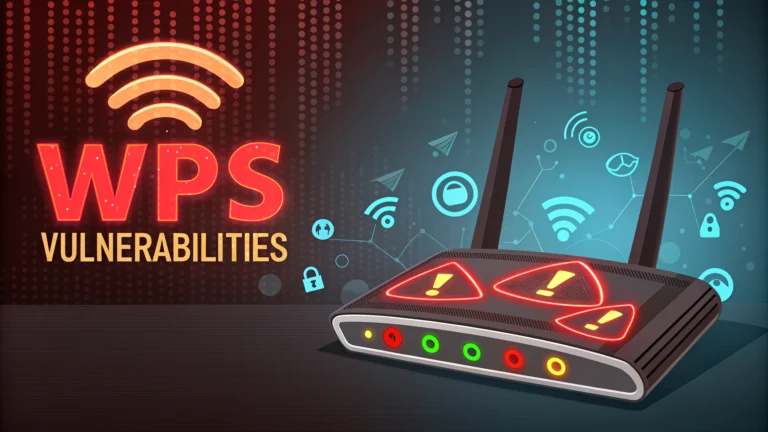WPS (Wi-Fi Protected Setup) vulnerabilities pose significant security risks to wireless networks, making them a prime target for penetration testers and malicious actors alike.
WPS was designed to simplify the process of connecting devices to WPA/WPA2 secured wireless networks, but its implementation contains several security flaws.
Common WPS Vulnerabilities
- PIN Authentication Weakness
- Online/Offline Brute Force Attacks
- Pixie Dust Attack Vulnerability
- Authentication Timeout Bypasses
Testing Tools
- Reaver – Primary tool for WPS brute force attacks
- Bully – Alternative WPS attack tool with additional features
- Pixiewps – Specialized tool for Pixie Dust attacks
- Wash – WPS scanning tool
Basic Testing Process
- Scan for WPS-enabled networks:
wash -i wlan0mon - Launch Reaver attack:
reaver -i wlan0mon -b [BSSID] -c [channel] -vv - Try Pixie Dust attack:
reaver -i wlan0mon -b [BSSID] -c [channel] -K 1
Prevention Methods
- Disable WPS completely on routers
- Update router firmware regularly
- Use strong WPA3 encryption where possible
- Enable rate limiting for failed attempts
Router manufacturers now implement better security measures, but older devices remain vulnerable to these attacks.
Legal Considerations
Testing WPS vulnerabilities without explicit permission is illegal and could result in serious legal consequences.
| Attack Type | Success Rate | Time Required |
|---|---|---|
| PIN Brute Force | High | 2-24 hours |
| Pixie Dust | Medium | 1-5 minutes |
For reporting vulnerabilities, contact Wi-Fi Alliance or the specific router manufacturer’s security team.
Testing these vulnerabilities requires a wireless adapter capable of packet injection and monitor mode.
Advanced Testing Considerations
WPS vulnerability testing requires careful attention to various environmental factors and device-specific characteristics that can impact success rates.
Signal Optimization
- Maintain close proximity to target device
- Minimize radio interference
- Use appropriate antenna positioning
- Monitor signal strength throughout testing
Common Testing Challenges
- Rate limiting mechanisms
- Device lockouts
- Firmware variations
- WPS implementation differences
Documentation Requirements
Professional vulnerability testing requires comprehensive documentation of all findings and methodologies used.
Essential Documentation Elements
- Initial network state
- Tools and versions used
- Attack vectors attempted
- Success/failure outcomes
- Time stamps for all activities
Conclusion
WPS vulnerabilities continue to present significant security risks, particularly in legacy systems and improperly configured networks. While newer security implementations have addressed many traditional WPS weaknesses, the protocol remains a potential attack vector requiring regular security assessment and proper hardening measures.
Additional Resources
- Wi-Fi Alliance Security Guidelines
- Router Manufacturer Security Bulletins
- WPS Implementation Standards
- Security Testing Frameworks
FAQs
- What is WPS (Wi-Fi Protected Setup) and why is it vulnerable?
WPS is a network security standard designed to simplify wireless network configuration. It’s vulnerable because of its 8-digit PIN mechanism, which can be broken down into two 4-digit segments, making brute force attacks significantly easier. - What is the Pixie Dust attack in WPS?
The Pixie Dust attack exploits a vulnerability in certain WPS implementations where weak randomization is used in the key generation process. This allows attackers to recover the WPS PIN offline within minutes or hours instead of days. - Which wireless routers are most susceptible to WPS attacks?
Routers manufactured before 2014, particularly Ralink, Realtek, and Broadcom chipsets, are most vulnerable. Many budget routers still use vulnerable WPS implementations despite known security issues. - How can I test if my router is vulnerable to WPS attacks?
Tools like Reaver, Bully, and Wash can be used to detect and test WPS vulnerabilities. These tools can identify if WPS is enabled and attempt various attack methods to validate security. - What is the null pin vulnerability in WPS?
The null pin vulnerability is a WPS implementation flaw where some routers accept a blank or null PIN, allowing unauthorized access without requiring the actual WPS PIN. - How does rate limiting affect WPS penetration testing?
Rate limiting is a security measure that temporarily blocks WPS authentication attempts after several failures. This can significantly increase the time needed for penetration testing and may require waiting periods between attempts. - What security measures can prevent WPS attacks?
Disabling WPS entirely, using WPS-free firmware like DD-WRT, implementing proper rate limiting, and regularly updating router firmware are effective security measures against WPS attacks. - How can I identify if a router has WPS enabled during penetration testing?
Using tools like Wash or Airodump-ng with WPS detection capabilities can identify routers with active WPS. These tools can also show whether the router has rate limiting or other protective measures enabled. - What is the online vs. offline PIN recovery method in WPS attacks?
Online PIN recovery involves active attempts against the router, while offline recovery (like Pixie Dust) extracts necessary information first and then performs calculations locally without further router interaction. - What makes the PIN authentication in WPS inherently weak?
The WPS PIN system’s design flaw lies in its verification process, which confirms the first 4 digits separately from the last 4 digits, reducing the theoretical keyspace from 100 million to just 11,000 combinations.







